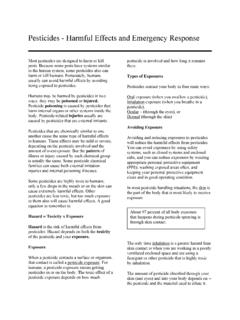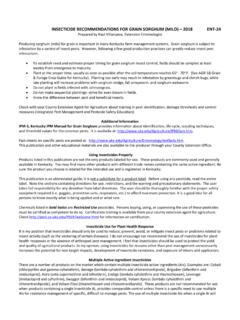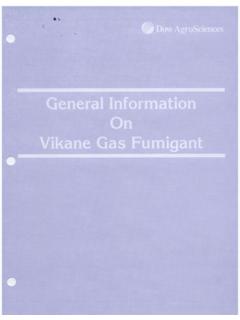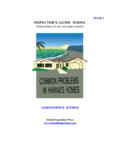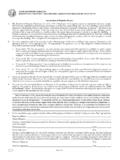Transcription of Categories 1b & 7c FUMIGATION TRAINING …
1 Categories 1b & 7cFUMIGATION TRAINING MANUALI ntroductionThe most effective way to reach pests in their mostremote hiding places is through FUMIGATION , the use ofpoisonous gases to kill pests in an enclosed area. To beeffective, fumigants must reach target pests as are "wide-spectrum" pesticides, killing allspecies of arthropods and rodents that are likely to befound in a building. They are also volatile pesticideswhose vapors enter the insect's body through the bodywall or breathing system. Fumigants penetrate to manyareas of a building not reached by sprays or dusts, evenpenetrating to the burrows of wood-infesting insects, aswell as to the center of tightly packed commodities,such as tobacco in hogsheads, bales, cases or grain inlarge silos or bulking bins.
2 A fumigant gas generallydoes not leave unsightly, odorous, or also has certain disadvantages. Highlyskilled, experienced, and licensed are required since allfumigants are extremely hazardous to use. Theapplication of fumigants is limited to areas, spaces,items, or commodities that can be tightly structures must be sealed as air tight aspossible and their occupants must leave, sometimes forseven days or longer. Some fumigants may damageitems in the area being fumigated. Also, fumigationgenerally costs more than other pest control procedures,and fumigants leave no protective residue so that ispossible immediately after are Restricted-Use pesticides because oftheir high acute toxicity, primarily by inhalation.
3 Theycan act as respiratory poisons, anesthetics or narcotics,or enzyme poisons. Because of their gaseous nature andacute inhalation toxicity, fumigant products are labeledas Toxicity Category I and all fumigants will havewarnings such as " .. Keep Out of Reach ofChildren .. Poison," and the skull and symbol. Thelabel contains information on using the productcorrectly, obtaining practical pest control, storing theproduct safely, and disposing of the containers andresidue of the fumigant correctly. The label also statesantidotes and first-aid treatment, in case a humanshould be poisoned during a use of a fumigant in a manner inconsistent withthe label may be in violation of the law.
4 If a personviolates the Federal Insecticide, Fungicide, and Act he:or she may be subjected to civil penalties as much as$5,000 for each offense, or criminal penalties as muchas $25,000 or one year in prison, or both. It is unlawfulto transfer a fumigant from its original container toanother unmarked fumigants are highly toxic and require trainedpersonnel for application. Anyone handling fumigantsshould be thoroughly familiar with applicationprocedures, safety equipment, first-aid treatment, anddisposal procedures. At least two people should alwaysbe present when using fumigants and both should havethe proper respiratory equipment for the particularfumigant being ideal fumigant should not change or impair thetreated commodity in any way, nor should it leave anyresidue which could be hazardous during processing orharmful to the consumer.
5 The EPA has determined theamount of pesticide residue that may safely remain inor on agricultural products as well as processed is called "tolerance." The EPA has also establishedexposure limits, which are the levels of fumigantconcentration above which it is not safe for people(workers) to be quantity of a fumigant to be applied in sealedbuildings, vacuum chambers, rail cars, and to packedcommodities under tarpaulins is determined by thevolume (cubic feet) of the space. In most cases, noallowances are made for the space occupied by thecommodities.
6 In grain silos or bulking bins, thequantity of a fumigant to be applied is calculated perton or per 1,000 bushels of grain. The dosage rate offumigants that are applied to the soil for tobacco bedsin most cases is based on the size of the bed (such as 9100 or 12 100) or the number of square feet to befumigated. Of course, the label of each fumigantdetermines the basis for applying the it is ever necessary to enter a structure when it isunder FUMIGATION , enter with a partner and the properrespiratory protection. After aeration, do not occupyfumigated premises until the FUMIGATION supervisor hastested the fumigated area with the proper equipmentand has announced the premises clear and safe to FUMIGATION 's effectiveness can easily be checked byplacing test cages of live target insects in various partsof the building, area, or commodity to be test cages after FUMIGATION for a mortalitycount of the insects.
7 Store all fumigants in locked, well-ventilated fumigants are pesticides, fumigators should befamiliar with the general considerations in pesticide use:the laws and regulations governing pesticide registrationand application; safety, environmental effects ofpesticides; pest biology and pest recognition; and labelsand labeling. The information given here on fumigationshould be used in conjunction with the core manual for allcategories of pesticide applicators Applying has two Categories of commercial fumigators;1 C, FUMIGATION Agriculture-related non-residential forapplicators controlling pests by FUMIGATION in enclosedspaces not including residential structures; and 7C, FUMIGATION including residential structures.
8 As ofFebruary 1,1988, all uses of all formulations of methylbromide are classified as Restricted-Use. Farmers andother landowners who wish to apply methyl bromide asa soil fumigant on their own lands must becomecertified as private of FumigationThe two types of FUMIGATION and their methodscurrently in use are listed FUMIGATION : Chamber and vault FUMIGATION Vacuum chamber FUMIGATION Vehicle FUMIGATION : railroad car, truck or van Tarpaulin FUMIGATION Spot FUMIGATION Structural FUMIGATION Empty building FUMIGATION : warehouse, grainelevator, food processing plant, mill, restaurant Shipboard, in transit ship or FUMIGATION Farm grain storage FUMIGATION Rodent burrow FUMIGATION FUMIGATION of beehives, supers and other FUMIGATION .
9 Field, nursery, greenhouse and seed or transplant bedsoils Non-tarp FUMIGATION by & Nature of FumigantsA number of fumigant active ingredients formerly usedhave either been canceled entirely or have had their usesstrictly limited in the All space fumigant products,and several soil fumigant products, especially thosecontaining chloropicrin and/or methyl bromide, are nowlabeled are broad spectrum pesticides that can act asrespiratory poisons, anesthetics or narcotics, or enzymepoisons. They are chemically simple molecules, but theycan exert potent and wide-ranging effects on the targetorganisms.
10 Because of their gaseous nature and acuteinhalation toxicity, fumigant products are labeled asToxicity Category I with the signal word Danger, orDanger-Poison with the skull and crossbones following section lists and describes the activeingredients that are still available and legal to bromide is formulated as a liquid and vaporunder pressure. It is odorless, non-flammable, andgenerally not corrosive nor irritating to eyes as a it is highly toxic by inhalation and also odorless,many formulations contain chloropicm as a warningagent on non-food products.
